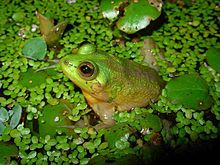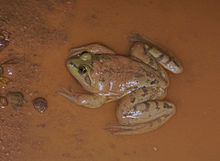| Pseudis paradoxa | |
|---|---|

| |

| |
| Two colour variants: | |
| Conservation status | |
 Least Concern (IUCN 3.1) | |
| Scientific classification | |
| Domain: | Eukaryota |
| Kingdom: | Animalia |
| Phylum: | Chordata |
| Class: | Amphibia |
| Order: | Anura |
| Family: | Hylidae |
| Genus: | Pseudis |
| Species: | P. paradoxa |
| Binomial name | |
| Pseudis paradoxa (Linnaeus, 1758) | |
Pseudis paradoxa, known as the paradoxical frog or shrinking frog, is a species of hylid frog from South America. Its name refers to the very large—up to 27 cm (11 in) long—tadpole (the world's longest), which in turn "shrinks" during metamorphosis into an ordinary-sized frog, only about a quarter or third of its former length. Although the recordholder was a tadpole in Amapá that belonged to this species, others in the genus Pseudis also have large tadpoles and ordinary-sized adults.
Distribution and habitat
The species inhabits ponds, lakes, lagoons and similar waters from the Amazon and the Guianas, to Venezuela and Trinidad, with a disjunct distribution in the Magdalena River watershed in Colombia and adjacent far western Venezuela. More southerly populations from the Pantanal region to northeastern Argentina have been recognized as a subspecies, but are now often considered a full species, P. platensis, although the validity of this split is questionable.
Appearance and behavior

 Mating pair in São Paulo, Brazil (left), models of full-grown tadpole and adult frog (right)
Mating pair in São Paulo, Brazil (left), models of full-grown tadpole and adult frog (right)
The adult frogs of P. paradoxa have a snout–to–vent length of 3.4–7.6 cm (1.3–3.0 in) and are green to brown coloured with dark green, olive or dark brownish stripes or mottling; the pattern and hue varies significantly.
The female of P. paradoxa lay eggs among water plants; the eggs develop into tadpoles. They always reach a large size, but there are noticeable local variations in the final size of the tadpoles, with those in large temporary waters with plenty of food and few aquatic predators growing larger than those in smaller waters with less food or waters with more aquatic predators.
The tadpoles feed mostly on algae. The adult frogs, which are active both day and night and always in or near water, eat insects (such as flies, beetles, true bugs, plantsuckers, butterflies, moths and dragonflies) and other invertebrates (such as crabs), and small frogs. When threatened, the frog uses its strong toes with an extra joint to stir up the muddy bottom and hide. The frog also uses this mechanism to find food on the bottom of lakes and ponds.
Potential use in medicine
In March 2008, scientists working from the Universities of Ulster and United Arab Emirates released findings of a study on pseudin-2, a skin compound which protects the paradoxical frog from infection. This work found that a synthetic version of this compound was able to stimulate the secretion of insulin in pancreatic cells under laboratory conditions without toxicity to the cells. As such, this synthetic medicine could be used in the treatment of Type 2 diabetes.
References
- Ariadne Angulo, Diego Baldo (2010). "Pseudis paradoxa". IUCN Red List of Threatened Species. 2010: e.T55904A11385563. doi:10.2305/IUCN.UK.2010-2.RLTS.T55904A11385563.en.
- Frost, Darrel R. (2013). "Pseudis paradoxa (Linnaeus, 1758)". Amphibian Species of the World 5.6, an Online Reference. American Museum of Natural History. Retrieved 24 October 2013.
- Emerson, S. B. (1988). "The giant tadpole of Pseudis paradoxa". Biological Journal of the Linnean Society. 34 (2): 93–104. doi:10.1111/j.1095-8312.1988.tb01951.x.
- ^ Garda, A. A.; D.J. Santana; V.d. Avelar São Pedro (2010). "Taxonomic characterization of Paradoxical frogs (Anura, Hylidae, Pseudae): geographic distribution, external morphology, and morphometry". Zootaxa. 2666: 1–28. doi:10.11646/zootaxa.2666.1.1.
- Bokermann, W.C.A. (1967). "Girinos de anfíbios brasileiros—3: sôbre um girino gigante de Pseudis paradoxa (Amphibia, Pseudidae)". Revista Brasileira de Biologia. 27: 209–212.
- ^ Frost, Darrel R. (2020). "Search for Taxon: Pseudis". Amphibian Species of the World, an Online Reference. Version 6.0. American Museum of Natural History, New York. Retrieved 10 January 2020.
- Solana, L.A.R.; F.V. Salinas; A.A.G. Vargas (2016). "Pseudis paradoxa (Linnaeus, 1758): northward extension of the known distribution range in Colombia". Herpetozoa. 28 (3/4): 192–193.
- ^ Halliday, T. (2016). The Book of Frogs: A Life-Size Guide to Six Hundred Species from around the World. University of Chicago Press. p. 320. ISBN 978-0226184654.
- ^ Franklyn, D. (2015). Pseudis paradoxa (Paradoxical Frog). The Online Guide to the Animals of Trinidad and Tobago. Retrieved 7 January 2020
- Abdel-Wahab, Y.H.A.; Power, G.J.; Ng, M.T.; Flatt, P.R.; Conlon, J.M. (2008). "Insulin-releasing properties of the frog skin peptide pseudin-2 and its -substituted analogue". Biological Chemistry. 389 (2): 143–148. doi:10.1515/BC.2008.018. PMID 18163889. S2CID 5411214.
- "Health | Frog skin diabetes treatment hope". BBC News. 3 March 2008. Retrieved 9 October 2013.
External links
 Media related to Pseudis paradoxa at Wikimedia Commons
Media related to Pseudis paradoxa at Wikimedia Commons The dictionary definition of paradoxical frog at Wiktionary
The dictionary definition of paradoxical frog at Wiktionary
| Taxon identifiers | |
|---|---|
| Pseudis paradoxa | |
| Rana paradoxa | |